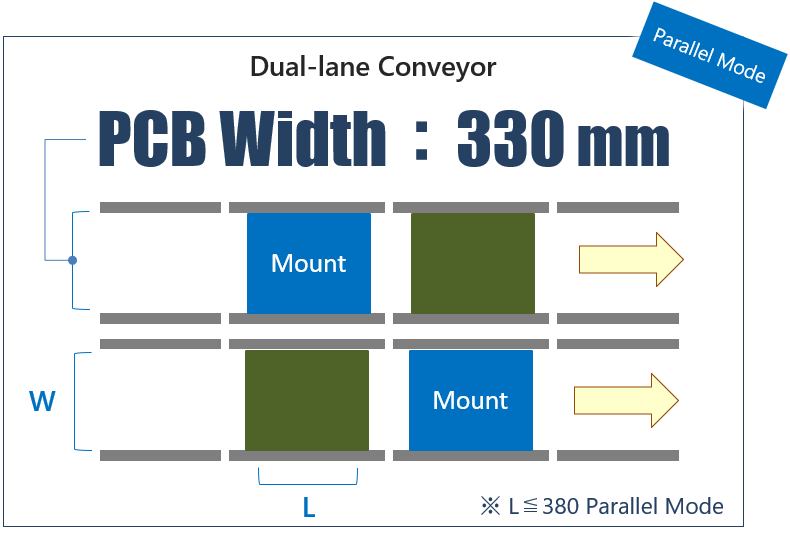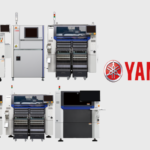ASIA ELECTRONICS INDUSTRYYOUR WINDOW TO SMART MANUFACTURING
Dual Lane SMT Boosts Throughput, Flexibility
Nowadays, internet of things (IoT) applications and automotive electrification are among the most important markets for manufacturers. In fact, these two markets have been stirring demand for large numbers of a wide range of electronic device types.
According to ResearchGate, more than 50 billion IoT devices, such as smart home monitors, wearables, and industrial sensors, connect to the internet. Moreover, over 10 billion more devices connect to the internet every year.
In automotive, the pace of electrification continues to accelerate. Particularly, to improve economy, lower emissions, increase safety, and enhance driver and passenger experiences. Increasingly sophisticated infotainment and driver-monitoring systems, advanced driver-assistance systems (ADAS), electronically controlled lighting, and electric propulsion mean emerging new models contain hundreds of circuit boards populated with processors, communication ICs, power semiconductors, high-power LED arrays, and more.
The number and diversity of these technologically advanced devices are disrupting the traditional division in electronic manufacturing. Particularly, between high-mix/low-volume and low-mix/high-volume. Thus, OEM and EMS businesses need to produce a high mix of different product types in high volumes and must always maintain high productivity.
Responding to Fast-Growing Markets
Dual-lane surface-mount assembly equipment offers a solution by allowing simultaneous assembly of PCBs in each lane. This helps manufacturers respond to fast-growing markets in several ways.
First, dual lanes allow rapid scaling of production capacity and increased efficiency. Two lanes operating simultaneously can process more PCBs within the same timeframe, enabling higher volumes to be produced.
Next, dual lane enables manufacturers to assemble a high mix of different product types efficiently. Each lane can be configured to handle a specific product or product variant. Thus, allowing them to produce different types simultaneously. This flexibility is crucial in markets where a wide range of product types with varying specifications and features are required.
Finally, dual-lane assembly helps optimize floorspace utilization by raising the production throughput without significantly increasing the equipment footprint.
As manufacturers need to produce a high mix of products, dual-lane assembly offers a cost-effective and space-efficient solution to the challenge. With the evolutionary changes in the latest dual-lane equipment, it is ready to deliver the performance advantages it has always promised.
Throughput with Flexibility
With the arrival of the latest generation of equipment such as the Yamaha YR series advanced dual-lane machines, both lanes have equal priority by allowing an equal range of adjustment and supporting the same automated features.
The YRP10DL dual-lane screen printer and YRM20DL dual-lane mounter allow maximum PCB size up to 330mm in dual-lane mode (figure 1) and so can be connected together directly. Historically, a dual-lane printer may have fed two separate mounters via a custom conveyor that adds complexity and cost. Alternatively, a single printer may have directed boards into a dual-lane mounter via a split conveyor.

The maximum rail width of 330mm is greater than typical preceding equipment models and so allows larger panel sizes that contain extra PCBs (figure 2a). Similarly, portable carriers for flexible printed circuit (FPC) substrates can contain 50% more units (figure 2b) by taking advantage of the expanded rail width.

Mounting Modes
The YRM20DL mounter allows multiple placement operating modes to enhance productivity. These include parallel and alternate modes with two separate mounting stages and over-drive flexibility. These extend the head non-interference area to reduce waiting time for alternate mode assembly and thereby improve productivity. In parallel mode, the 4-split conveyor reduces transport distance. The parallel and alternate modes allow an extension conveyor option that increases the length up to 380mm.
When setup in parallel mode, the two lanes can operate completely independently, each having its own setup. Non-stop changeover of feeder carts is possible. This allows manufacturers to assign a product to lane 1 with the flexibility to assign the same or a different product to lane 2, and change over either lane independently. Parallel mode is most useful when producing PCBs with a small number of component types.
In an alternate mode, either head can place components in either lane, and feeders can share between both lanes. Each lane can run the same product or different products. This approach can be used to populate boards that contain a large variety of component types. Although, the cycle time may be short. Parts sharing and productivity leveling are possible.
In addition, the YRM20DL can operate in hybrid mode to handle the case where each lane builds a different product, and one of the two assemblies is more heavily populated than the other. In hybrid mode, the less busy head can place components in the other lane to help accelerate the cycle time. This allows extra flexibility when production capacity is a priority and the feeder set positions are not suitable for parallel mode. Parts sharing and productivity leveling are possible in hybrid mode.
The production mode of each mounter within a line can be changed independently to maximize productivity and ensure efficient use of feeder slots. This allows mixed-mode production using, as shown in figure 3, parallel mode for chip mounting and alternate mode for mounting odd-shaped components that require many feeders. Figure 3 also shows alternate modes applied to one side only, for assembling odd-shaped components.

The YRM20DL also contains advanced features from the existing single-lane model, with enhanced PCB transfer capacity and stopper-less board positioning. The requirement for stopper-less positioning originated in the automotive industry, to preserve the integrity of assemblies. The mounter also links push-up pin activation and PCB clamping, tightly coordinating the two actions to minimize PCB transfer time. In addition, non-stop program change and non-stop carriage exchange enable fast changeovers between products.
Non-stop program change maximizes efficiency in either case where the PCB width and backup position are the same or different. When the incoming job width and backup-pin position are the same, the machine can simply finish the current PCB and change the program for the next job.
On the other hand, when the width or back position is different, the machine allows the incoming PCB to wait before entering. The new width setting is applied after the last PCB of the current job leaves the machine.
The non-stop carriage exchange feature provides safe removal and replacement of carriages without stopping the machine. One lane can continue production while the automatic carriage setup runs on the other lane. This effectively allows the two lanes to run independently, with each building a different mix of products.
Seamless End-to-End Dual Lane
The YRP10 DL dual-lane printer, similarly, provides flexible rail-width settings and automated features active on each lane. When used together, these machines enable the entire surface-mount line to work independent dual lanes from end to end for maximum flexibility and throughput, whether manufacturing a low or high mix of product types.
The printer performs as two screen printers inline, each operating with full independence and both supporting full automated program changeover to minimize downtime and maximize productivity.
The YRi-V DL inspection machine provides dual-lane capability with a newly developed conveyor that has movable lanes, which eases connection to other inline equipment either upstream or downstream. It can handle a large range of PCB sizes, up to 320mm x 2 in dual-lane mode. It can also handle custom PCB sizes up to 1200mm x 610mm. When both lanes are assigned to handle a small PCB, the rails can be placed close together to minimize the excursion time for the inspection head.
The YRi-V also adds new algorithms that improve the inspection of solder fillets per IPC standards. Updated camera settings are also available to handle inspection challenges posed by the latest semiconductor package styles, such as wafer-level chip-scale package (WL-CSP). The package surface tends to produce reflections that challenge the capabilities of conventional inspection equipment (figure 4).

Further enhancements include an 8-angle 3D camera array that accelerates image capture and a 4-angle 20Mp camera to capture high-resolution images of features such as solder joints. These are known to be challenging for conventional machines to capture and assess accurately.
When used together in the same line, the dual-lane printer, mounter, and inspection means seamless end-to-end dual-lane manufacturing. In the past, achieving this has needed various combinations of single-lane machines connected with special conveyoring, resulting in a complex line layout that can be expensive and time-consuming to design and install.
Conclusion
The increasing demand for a high mix of different product types in high volumes is creating a strong case for dual-lane surface-mount assembly. Thus, the latest generation of equipment maximizes the performance potential of dual-lane to enhance production throughput, flexibility, and productivity.
Image Credit: All images courtesy of Yamaha SMT Section
About This Article:
Contents of this article has been taken from the SMT Section of Yamaha Motor




